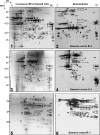Identification of in vivo-expressed immunogenic proteins by serological proteome analysis of the Bacillus anthracis secretome
- PMID: 17353282
- PMCID: PMC1932864
- DOI: 10.1128/IAI.02029-06
Identification of in vivo-expressed immunogenic proteins by serological proteome analysis of the Bacillus anthracis secretome
Abstract
In a previous comparative proteomic study of Bacillus anthracis examining the influence of the virulence plasmids and of various growth conditions on the composition of the bacterial secretome, we identified 64 abundantly expressed proteins (T. Chitlaru, O. Gat, Y. Gozlan, N. Ariel, and A. Shafferman, J. Bacteriol. 188:3551-3571, 2006). Using a battery of sera from B. anthracis-infected animals, in the present study we demonstrated that 49 of these proteins are immunogenic. Thirty-eight B. anthracis immunogens are documented in this study for the first time. The relative immunogenicities of the 49 secreted proteins appear to span a >10,000-fold range. The proteins eliciting the highest humoral response in the course of infection include, in addition to the well-established immunogens protective antigen (PA), Sap, and EA1, GroEL (BA0267), AhpC (BA0345), MntA (BA3189), HtrA (BA3660), 2,3-cyclic nucleotide diesterase (BA4346), collagen adhesin (BAS5205), an alanine amidase (BA0898), and an endopeptidase (BA1952), as well as three proteins having unknown functions (BA0796, BA0799, and BA0307). Of these 14 highly potent secreted immunogens, 11 are known to be associated with virulence and pathogenicity in B. anthracis or in other bacterial pathogens. Combining the results reported here with the results of a similar study of the membranal proteome of B. anthracis (T. Chitlaru, N. Ariel, A. Zvi, M. Lion, B. Velan, A. Shafferman, and E. Elhanany, Proteomics 4:677-691, 2004) and the results obtained in a functional genomic search for immunogens (O. Gat, H. Grosfeld, N. Ariel, I. Inbar, G. Zaide, Y. Broder, A. Zvi, T. Chitlaru, Z. Altboum, D. Stein, S. Cohen, and A. Shafferman, Infect. Immun. 74:3987-4001, 2006), we generated a list of 84 in vivo-expressed immunogens for future evaluation for vaccine development, diagnostics, and/or therapeutic intervention. In a preliminary study, the efficacies of eight immunogens following DNA immunization of guinea pigs were compared to the efficacy of a PA DNA vaccine. All eight immunogens induced specific high antibody titers comparable to the titers elicited by PA; however, unlike PA, none of them provided protection against a lethal challenge (50 50% lethal doses) of virulent B. anthracis strain Vollum spores.
Figures




Similar articles
-
Use of a promoter trap system in Bacillus anthracis and Bacillus subtilis for the development of recombinant protective antigen-based vaccines.Infect Immun. 2003 Feb;71(2):801-13. doi: 10.1128/IAI.71.2.801-813.2003. Infect Immun. 2003. PMID: 12540560 Free PMC article.
-
Contribution of immunological memory to protective immunity conferred by a Bacillus anthracis protective antigen-based vaccine.Infect Immun. 2004 Jun;72(6):3471-7. doi: 10.1128/IAI.72.6.3471-3477.2004. Infect Immun. 2004. PMID: 15155654 Free PMC article.
-
Identification of chromosomally encoded membranal polypeptides of Bacillus anthracis by a proteomic analysis: prevalence of proteins containing S-layer homology domains.Proteomics. 2004 Mar;4(3):677-91. doi: 10.1002/pmic.200300575. Proteomics. 2004. PMID: 14997491
-
Host immunity to Bacillus anthracis lethal factor and other immunogens: implications for vaccine design.Expert Rev Vaccines. 2015 Mar;14(3):429-34. doi: 10.1586/14760584.2015.981533. Epub 2014 Nov 17. Expert Rev Vaccines. 2015. PMID: 25400140 Review.
-
Proteomic studies of Bacillus anthracis.Future Microbiol. 2009 Oct;4(8):983-98. doi: 10.2217/fmb.09.73. Future Microbiol. 2009. PMID: 19824790 Review.
Cited by
-
The Bacillus cereus Group: Bacillus Species with Pathogenic Potential.Microbiol Spectr. 2019 May;7(3):10.1128/microbiolspec.gpp3-0032-2018. doi: 10.1128/microbiolspec.GPP3-0032-2018. Microbiol Spectr. 2019. PMID: 31111815 Free PMC article. Review.
-
The adenylyl cyclase activity of anthrax edema factor.Mol Aspects Med. 2009 Dec;30(6):423-30. doi: 10.1016/j.mam.2009.06.001. Epub 2009 Jun 26. Mol Aspects Med. 2009. PMID: 19560485 Free PMC article. Review.
-
A multipathogen DNA vaccine elicits protective immune responses against two class A bioterrorism agents, anthrax and botulism.Appl Microbiol Biotechnol. 2022 Feb;106(4):1531-1542. doi: 10.1007/s00253-022-11812-6. Epub 2022 Feb 10. Appl Microbiol Biotechnol. 2022. PMID: 35141866 Free PMC article.
-
Bacillus anthracis protease InhA increases blood-brain barrier permeability and contributes to cerebral hemorrhages.PLoS One. 2011 Mar 17;6(3):e17921. doi: 10.1371/journal.pone.0017921. PLoS One. 2011. PMID: 21437287 Free PMC article.
-
Lipoprotein biosynthesis by prolipoprotein diacylglyceryl transferase is required for efficient spore germination and full virulence of Bacillus anthracis.Mol Microbiol. 2012 Jan;83(1):96-109. doi: 10.1111/j.1365-2958.2011.07915.x. Epub 2011 Nov 22. Mol Microbiol. 2012. PMID: 22103323 Free PMC article.
References
-
- Antelmann, H., H. Tjalsma, B. Voigt, S. Ohlmeier, S. Bron, S. J. M. Van Dijl, and M. Hecker. 2001. A proteomic view on genome-based signal peptide predictions. Genome Res. 11:1484-1502. - PubMed
-
- Antelmann, H., R. C. Williams, M. Miethke, A. Wipat, D. Albrecht, C. R. Harwood, and M. Hecker. 2005. The extracellular and cytoplasmic proteomes of the non-virulent Bacillus anthracis strain UM23C1-2. Proteomics 5:3684-3695. - PubMed
MeSH terms
Substances
LinkOut - more resources
Full Text Sources
Other Literature Sources
Research Materials
Miscellaneous

